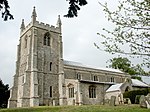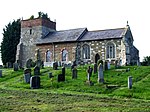Friskney Eaudyke

Friskney Eaudyke is a settlement in the civil parish of Friskney, and the East Lindsey district of Lincolnshire, England. It is 11 miles (20 km) north-east from Boston and 30 miles (50 km) east-southeast from the city and county town of Lincoln. Friskney Eaudyke is 1 mile (1.6 km) east from the parish village of Friskney, and the same distance north-east from the parish hamlet of Fold Hill. The A52 road, which runs locally from Boston to Skegness, is 800 yards (700 m) south-east.The settlement is centred on the northwest-to-southeast Eau Dyke Road, between Low Road at the north-west and the staggered junction with Sickling Lane and Chapel Lane at the south-east. Friskney Eaudyke comprises detached and semidetached houses, farms with associated buildings, a farm produce distribution company, a balloon supply & event company, a garage services company, and Grade II listed buildings.The listed Bridge Farmhouse, a late 18th-century two-storey red brick house, is on Low Road south from the junction with Eau Dyke Road. Over the junction and further north on Low Road is Ash Tree Farmhouse, a mid-18th to mid-19th-century gabled red brick house. At the north on Mill Lane off Low Road, and near the border with Wainfleet St Mary, is Hoyle's Windmill, of three-storeys and today converted to a storehouse by the addition of an attached building. Largely early 19th-century, it dates from 1730. At the south-west on Chapel Lane is the Grade II* listed 19th-century red brick Wesleyan Centenary Chapel, dating to 1839.In 1871 "Ancient British" pottery, and fragments of bone were found by workmen on Eaudyke Road at the south-east of the settlement. Kelly's Directory in 1885 noted the 1871 archeological finds by workmen as they were building the infants' school at 'Eaudyke'. The directory records a schoolmistress, and the Wesleyan chapel which it said was built in 1832. The listed trades at 'Eaudyke' in the 1933 Kelly's Directory included five farmers, a potato merchant, a saddler, a beer retailer, a shopkeeper, a grocer, a butcher, a baker, and a motor engineer.
Excerpt from the Wikipedia article Friskney Eaudyke (License: CC BY-SA 3.0, Authors, Images).Friskney Eaudyke
Eaudyke Road, East Lindsey Friskney
Geographical coordinates (GPS) Address Nearby Places Show on map
Geographical coordinates (GPS)
| Latitude | Longitude |
|---|---|
| N 53.080073 ° | E 0.19889653 ° |
Address
Eaudyke Road (Eau Dyke Road)
Eaudyke Road
PE22 8RU East Lindsey, Friskney
England, United Kingdom
Open on Google Maps










